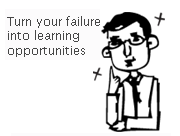Productive Failure
Productive Failure (Inductive and Deductive Learning)

Figure 1. Source: http://www.dik.co.jp/
Two mathematics teachers are having an exciting discussion in the staff-room about what might be more effective in how they will teach their Form two students.
Teacher A: I think we should present information carefully in organized ways: They have not learn much and we should first explain to students the procedures and principles and ask students to check on them. Then they can work in groups to solve the problems.
Teacher B: I think we can just let students plunge right into the problems before our teaching and let them try things out. They can work in groups and discuss how to solve the problems. After that, we can see what they have done and then explain the key principles and procedures.
Which one of the teachers do you agree with more? Explain.
Definition
There has been many debates on guided instruction versus open-inquiry, and productive failure is an approach developed to address the question of how to sequence instruction for effective teaching based on how people learn. A series of empirical studies has investigated and compared the two approaches of engaging students in solvinig complex, ill-structured problems with limited teacher support first followed by structured explanation, compared to presenting clear concepts first followed by problem solving later. The evidence clearly indicate that having students solve the problems before instruction is superior to explanation followed by application. While students usually cannot solve the problems first, their experience of failure is often productive and brings about more long-term successful learning.
Basic Assumptions and Principles
While students may struggle and ultimately fail or reach an impasse, researches by Kappu (2008, 2009, 2010) indicates that allowing students to reach an impasse
The underlying premise of this strategy is that structure or scaffolding can impose order, but limit a learners exploration of the complex problem to the constraints of the scaffold thus, in scaffolded learning a student may successfully solve a problem, but not move beyond the problem. (Kapur, 2008).
Primary Theorist
Manu Kapur

Figure 1. Manu Kapur. Source: http://reganmian.net/wiki/_media/pages:a_manu_kapur01.png
Manu Kapur, a researcher at the Learning Sciences Lab at the National Institute of Education of Singapore identified the teaching strategy productive failure, that using a low structure initial activity in inquiry learning can result in better learning outcomes than using an initial high structure activity.
Classroom Implication and Teaching Strategies
-
Understand what students know about a novel concept that they have not been taught yet
-
Afford opportunities to activate and differentiate prior and intuitive knowledge .to generate, explore, critique, and refine representations and methods for solving complex problems
-
Invariably, such a process leads to failure
But, this may precisely be the locus of deep learning provided some form of instructional structure follows subsequently
Resources
-
Kapur, M. (2008). Productive failure. Cognition and Instruction, 26(3), 379-424.
-
Kapur, M., & Kinzer, C. K. (2009). Productive failure in CSCL groups.International Journal of Computer-Supported Collaborative Learning, 4(1), 21-46.
-
Kapur, M. (2010). Productive failure in mathematical problem solving.Instructional Science, 38(6), 523-550.